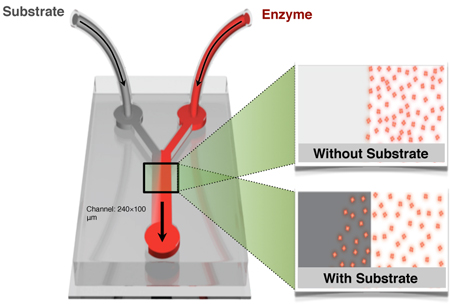 MRSEC researchers have recently discovered that enzymes - molecules that catalyze chemical reactions in cells - move during the reaction. Although this property is well known for motor proteins, it has not been previously known that movement is a general consequence of enzymatic reactions. This movement depends on the concentration of the enzyme's substrate (the fuel for its reaction) and causes individual enzyme molecules to "swim" to regions of higher fuel concentration, a phenomenon known as chemotaxis.
MRSEC researchers have recently discovered that enzymes - molecules that catalyze chemical reactions in cells - move during the reaction. Although this property is well known for motor proteins, it has not been previously known that movement is a general consequence of enzymatic reactions. This movement depends on the concentration of the enzyme's substrate (the fuel for its reaction) and causes individual enzyme molecules to "swim" to regions of higher fuel concentration, a phenomenon known as chemotaxis.
A Y-shaped microfluidic device generates a gradient in the concentration of substrate. Both catalase and urease enzyme molecules move towards areas of higher substrate concentration, the first demonstration of chemotaxis by enzyme molecules. By using glucose oxidase and glucose to generate a hydrogen peroxide gradient, we also induce the migration of catalase towards glucose oxidase – a more complex sequence of chemical triggers. This control over the motion of individual molecules through chemical gradients mimics similar processes in biology and extends our ability to manipulate objects on the nanoscale.